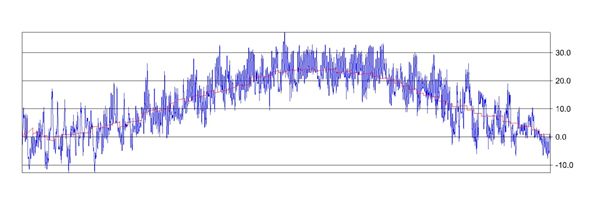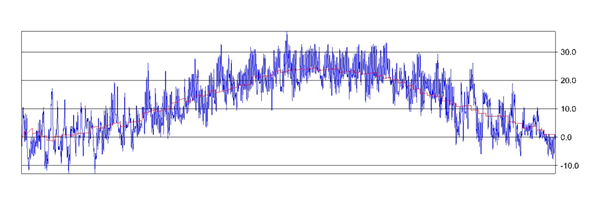Can weather files generated for energy modeling reflect worst and best case annual scenarios?
We rely on government-provided TMY (typical meteorological year) weather files to provide data for the weather parameter found in building performance simulation software. This includes industry standard software such as eQuest, Energy Plus, and Ecotect, as well as proprietary software developed in-house. The availability of TMY data makes it highly universal; however, the results represent typical extremes and cumulatively contribute to seasonal and annual averages, creating uncertainty about how realistic our energy model outputs may be.
The TMY Plus utility creates confidence intervals for the temperatures levels represented in the TMY file, allowing the user to understand to what degree the weather file can be expected to accurately predict real weather patterns. This helps with a variety of decisions, from determining the cost to condition a space, or the viability of foregoing mechanical systems altogether. It is also very useful in determining the range of conditions that passive systems must account for, and if a system will be sufficient to ensure occupant comfort. Alternatively, the best case scenario can demonstrate if passive systems will be functional if the weather is as good as expected with a 95% confidence interval. As we seek to reduce air conditioning or ponder the effect of more severe climatic circumstances on building performance, TMY Plus is instrumental in addressing those concerns.
Methodology

Figure 1. TMY Temperature

Figure 2. TMY PLUS BCS Temperature

Figure 3. TMY PLUS WCS Temperature
Hourly weather data was found for Philadelphia International Airport for the years 1991-2005. After preliminary sorting in Excel for missed or extra readings, we transferred the data into Grasshopper and applied a local linear regression on a 5-day scale, fitting each 5-day section with a linear estimation. A 95% prediction interval was formed for the temperature at any given hour, meaning that 95% of the time the temperature at hour H would fall between the upper and lower limit of the interval. Using these lower and upper confidence limits, a “best case scenario,” taking the readings with weather closest to human comfort range, and a “worst case scenario,” taking the readings with weather farthest from the human comfort range, were developed. For the purpose of this assessment, human comfort was determined as the zone from 14°C to 26°C.
In order for the temperatures to reflect observed weather conditions, an algorithm was developed to choose the actual recorded data, in 5-day ranges, that most closely fit the best and worst case scenarios. These hourly temperatures were then transferred into two distinct TMY3 files to use as weather input files for a building energy simulation.
The significance of the difference for the two weather files and the TMY file is apparent in the scatterplots below. Notice a TMY scatterplot (Figure 3) tends to center around the observed average line, while the worst case scenario scatterplot (Figure 1) contains a noticeable trend toward colder winter and hotter summer temperatures. The best case scenario plot, by comparison, illustrates an overall milder year.
To test the magnitude of difference between the best case, worst case, and standard TMY file, an energy model was run in Energy+ for each climate input file. A simple, single zone structure was built, and the energy consumption deviation between each example was noted. With the TMY file serving as an energy consumption baseline, the building model run with the best case climate scenario consumed 14.7% less energy, and the model run with the worst case scenario consumed 5.3% more energy than the TMY model run.


